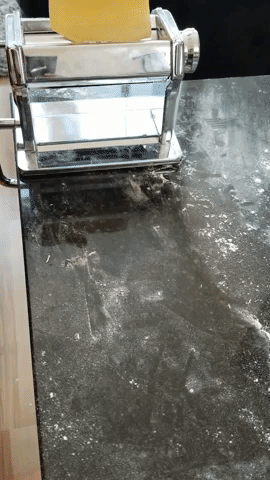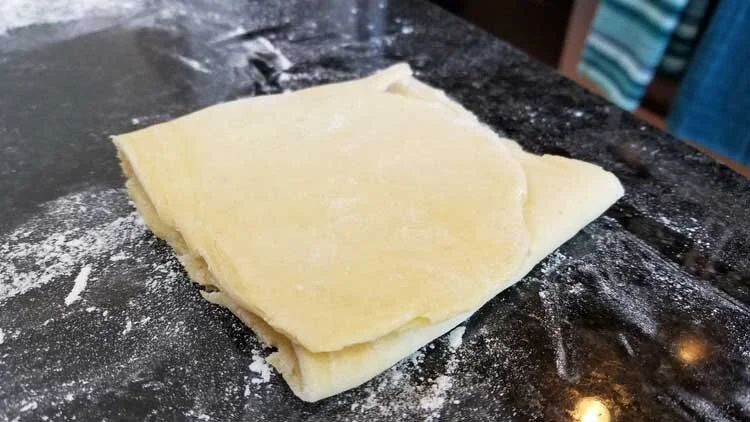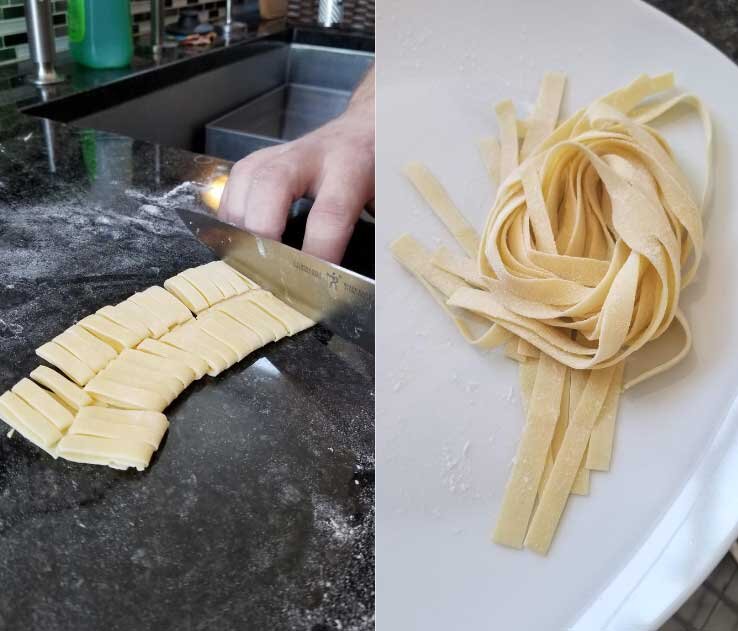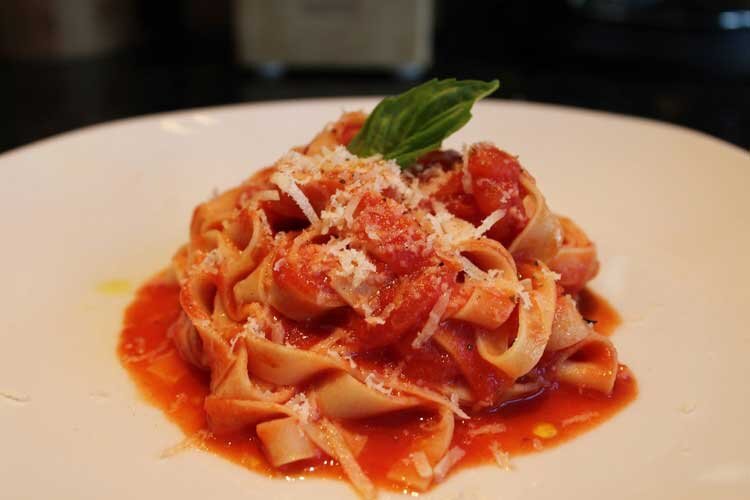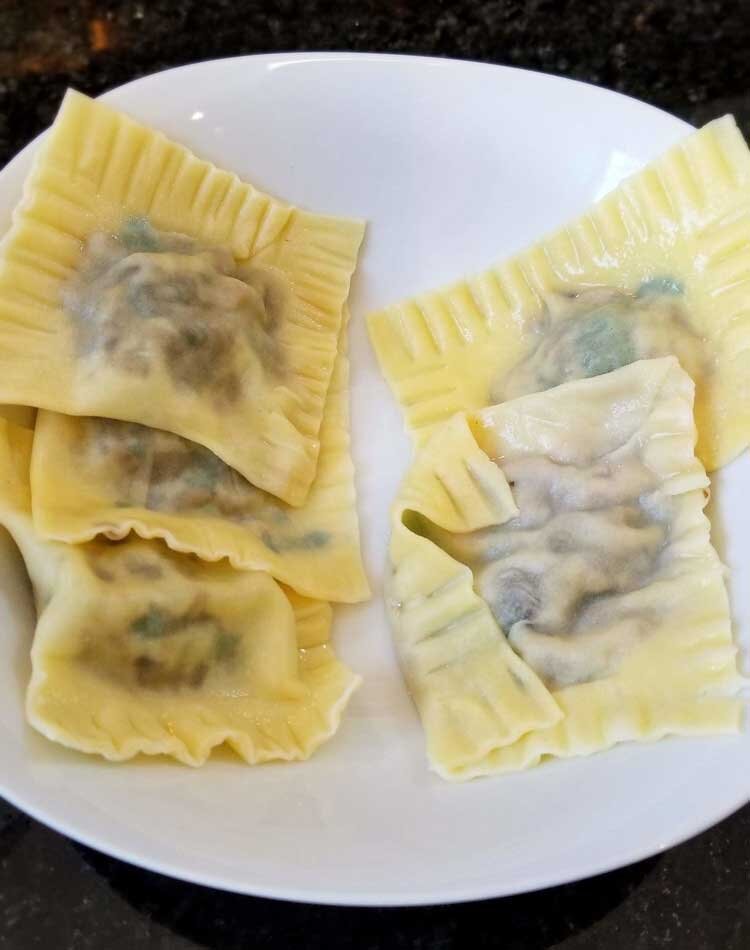How to Make Homemade Pasta Dough (And Other Pasta Tips)
Spaghetti. Linguine. Macaroni. Rottini. Do you eat pasta for breakfast, lunch, and dinner? Do you love pasta so much that you want to try making noodles from scratch, but have no idea how? Let us show you how a Mediocre Chef makes pasta dough!
We promise the results won’t be mediocre. It’ll be delicious!
How to Make Homemade Pasta Dough
The basic formula for fresh pasta dough is pretty simple: flour + something wet = pasta dough. The something wet is traditionally either eggs or water, but we recommend using eggs for your dough, especially if it’s your first time making pasta. This recipe has worked well for us:
Ingredients
1 cup of flour*
1 egg
3 egg yolks
½ tbsp olive oil
1 pinch of salt
*For what kind of flour to use, keep reading!
As with most dough, you’re going to need to combine your wet ingredients and your dry ingredients separately. Mix the flour and salt together in a large bowl, and whisk the eggs, egg yolks, and olive oil together in a separate bowl. Make a well in the center of your flour mixture and slowly start incorporating the wet ingredients into the dry ingredients with a fork.
Start mixing!
Eventually a very crumbly and shaggy dough will start to form. Once this happens, start to knead the dough with your hands on a lightly floured surface. Continue to knead the dough until it is soft and feels like play-dough — when you you poke it, it should bounce back! This part is definitely a work out, so get ready to be sore the next day. (We both decided to renew our gym memberships after making the pasta).
Once your dough is ready, wrap it in cling film and let it rest. We recommend letting it rest for at least half an hour, or up to 24 hours if you place it in the refrigerator!
We made two different types of dough to test!
What Is The Best Flour For Pasta?
Traditionally you should use durum wheat semolina flour or Italian 00 flour to make pasta.
That being said, if the only thing that you have on hand is general all purpose flour, you’ll be just fine. We decided to compare semolina vs all purpose flour to see if we noticed a difference and found that the semolina pasta dough was easier to work with and had a slightly better texture than the all purpose dough. We can’t say for sure whether or not that was because of flour or some other variable that we can’t account for, but we preferred the semolina flour dough.
All Purpose Flour vs Semolina Flour
If you want to try making fresh pasta for the first time and don’t want to shell out $$ on semolina flour, all purpose flour will work just fine!
How to Fix Your Dough If You Mess Up
If your dough is too dry, you’re not completely screwed — just add a bit of liquid! A few drops of water until the dough has the texture you want should be fine. Similarly, if your dough is too wet, add some flour until it’s soft and feels like play-dough. It’s really that simple.
How to Roll Out Pasta Dough
You’ve let your dough rest for the requisite amount of time, and now you’re getting hungry. It’s time for you to roll out your dough and get cooking! There are two different ways to roll out your pasta dough: with a pasta machine or with a rolling pin. Using a rolling pin is a perfectly acceptable way to work, especially if you don’t have the money to splurge on a fancy pasta machine.
Our new best friend.
No matter which method you choose, we recommend breaking the dough in half or into thirds in order to make things more manageable. Take a piece of your dough and start rolling. How hydrated your dough is will determine how easy this step is. (We’ve broken a sweat before trying to roll out tough dough by hand.) Just keep working the dough until it’s thin enough, and do try to work quickly. Pasta dough is notorious for drying out rapidly.
If you own, or have the means to afford a pasta machine, then use it (even a cheap $20 one should do the trick. It will make your life much easier.) You’ll also need to flatten it and shape it into a rough rectangle or oval shape. Then you’re going to want to pass the dough through the machine on its widest setting. Once that’s done, reduce the setting by one, and pass it through again. Keep repeating this until the dough is at your desired thickness.
🍝 Mediocre Tip: If you want, you can laminate your dough before rolling it out. This is easy to do with a pasta machine — first, pass your dough through the machine on its widest setting. Then, fold the dough in thirds, overlapping it. Gently roll it with a rolling pin, and repeat the process once or twice more — fold, roll, repeat.
The start of the lamination process.
The purpose of laminating the dough is to help even out the thickness, and it’ll prevent the ugly bumpy edges from forming. You can do this without a pasta machine, but it's going to be much more difficult and take much longer. Be sure to apply enough force with your rolling pin so that the folds stick together!
If you’ve followed our directions, then you should have a nice sheet of pasta dough! If you don’t then don’t worry — even we messed up the first few times.
This is very satisfying.
How to Make Different Pasta Shapes
Did you know that there are approximately 350 different types of pasta? So yea, we’re not going to cover them all — that’d be insanity. Instead, we’ll go over how to make some basic shapes, and will link to a few of our favourite pasta making videos for inspiration.
If you’re just starting out, long noodles or pasta sheets is probably what you’re going to make, as many of the short pastas require boards to give the pasta a specific texture (watch the videos below to see what we mean). However, there are a few short pastas you can easily make without any additional tools, such as farfalle, which just involves pinching together the long sides of a rectangular piece of dough together.
To make lasagna sheets, simply cut your pasta sheets to the desired length/shape for your pan. With your pasta in sheet form, you can also make delicious ravioli! Simply put your filling in a few mounds spaced out along one half the dough, and fold the other half of the dough over. Using your hands, press down to seal your individual raviolis, making sure to get all of the air out.
For long noodles, you have lots of options — you can cut your dough thin for dainty pasta like angel hair, or you can make wider cuts for tagliatelle. To make it easier on yourself, don’t try to cut your super long pasta sheet into long thin strips! It’ll be hard to get an even cut and there is an easier way to do it. Instead, take your long pasta sheet and cut it into a few sections. Then take the two ends of a section and make them meet in the middle. Do that a second time, and then cut your pasta! When you unfold your dough, you’ll have nice long strips of pasta.
🍝 Side Note: If you’re using a pasta machine, then it probably came with an attachment to cut long noodles like ours did. We opted to not use it for the post for two reasons:
Not everyone has one, so we wanted to show that you can cut noodles without needing a fancy attachment, and
Cutting pasta noodles by hand is more rustic, more fun, and is much more impressive to watch than putting them through a dinky little attachment thing.
Want to learn how to make more pasta shapes? Both of these videos are mesmerizing, and definitely worth a watch!
How to Make 29 Handmade Pasta Shapes with Luca D'Onofrio
How to Make Pasta Shapes with Gennaro Contaldo
How Long Do You Cook Homemade Pasta For?
Homemade pasta cooks a lot faster than dry pasta you buy at the grocery store! The cook time will depend on how hydrated your dough is, the thickness of your noodles, and how you prefer your pasta. Typically this is in between 1-3 minutes — we recommend tasting your noodles in 1 minute increments, until you get the right level of doneness.
Oh — and don’t forget to salt your water! This is very important. 🧂
Pasta Sauce Inspiration + Recipes
So you’ve made homemade pasta — now you have to pair it with a really amazing homemade sauce! (Because you’re not going to make pasta from scratch and use jarred sauce — that would be lame.)
You really can’t go wrong pairing pasta shapes with pasta sauces, but there are some pasta shapes that hold different sauces better, making it easier to eat. For example, long and skinny pastas work well with light sauces, while long and thicker pasta noodles are better at delivering rich sauces into your mouth. But there are no hard and fast rules that like “you can’t eat fettuccine with a light sauce” or “spaghetti noodles can only be paired with a red sauce”. You do you.
🍅 Homemade Marinara Sauce
Now for recipe inspiration — we used San Marzano tomatoes for the first time making our homemade marinara sauce. And man, our sauce was mad delicious. MAD.
All you need to make to make a simple homemade marinara sauce is olive oil, garlic (personal preference), a 28 oz can of tomatoes, a fresh sprig of basil, some crushed red pepper flakes, and salt. Slice your garlic super thin and add it to the hot oil to get soft (don’t let it brown). Crush your canned tomatoes by hand (real San Marzano tomatoes only come packed whole or filleted — more on that below), and add your tomatoes along with one cup of water to your skillet. Stir in your salt and red pepper flakes, and place a basil spring on top so the delicious herb gets infused into your sauce! Remove it before serving.
We’re really proud of this photo.
🍅 Mediocre Tip: If you decide to use San Marzano tomatoes, make sure you’re not getting ripped off an over-paying for tomatoes that aren’t true San Marzano tomatoes. Labels can be misleading!
🍄 Mushroom Ravioli
We found this video while researching ravioli recipes and we decided to go with it. It also doesn’t hurt that he sounds like one of the Free Folk from Game of Thrones (Dear HBO: please don’t sue us for mentioning Game of Thrones. Also please make it easier to watch GoT online in Canada).
What you’re going to want to do is to sauté some shallots, finely diced mushrooms, garlic, salt, and pepper in some olive oil until the mushrooms are brown and delicious. Put everything into a bowl and add roughly chopped parsley, finely diced chives, lemon zest, Parmesan cheese, nutmeg, and a touch of cream to bind everything. Mix it all together and you have a wonderfully delicious ravioli filling.
Semolina ravioli vs all purpose flour ravioli.
🍝 Mediocre Tip: The next time that we make this we’ll probably throw the filling in a food processor after to make a nice puree. This will make the texture a lot nicer!
For the sauce, sauté some roughly chopped mushrooms, shallots, garlic, salt, and pepper in olive oil until the mushrooms are brown and delicious. Deglaze the pan with some vegetable stock (or chicken stock if that’s all you have) and let the stock reduce. Add in some cream and let that reduce as well. Finally, add finely diced chives and some chiffonade basil leaves and the sauce is done.
Delicious mushroom sauce.
🌿 Sage and Butter Sauce
If you like sage, you’ll be down with sage and butter sauce. This sauce is super rich and decadent because the base is, well, butter (duh). Melt butter in a pan, and when it starts to bubble add some chopped garlic. Cook and stir. Then add your chopped sage, and cook and stir some more. Once your butter starts to take on a light brown colour, remove from heat and season with pepper.
There was too much sauce in the bowl — but it was good!
This sauce is very rich so you want to go on the light side when coating your pasta. If you find it too rich, we suggest adding some lemon juice — the acidity will help cut the fat!
🍝 Other Pasta Recipes We Like
Making homemade pasta might seem scary, especially if you don’t have a pasta machine, but we hope you take a leap of faith and try making homemade pasta! Dry pasta has its place — for those rushed weeknights when you just need a quick meal. Start your pasta adventure on a lazy Sunday and discover the joys of making it from scratch! You’ll probably impress yourself.
What’s your favourite shape of pasta? Let us know in the comments below!






